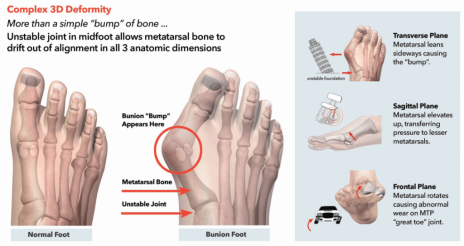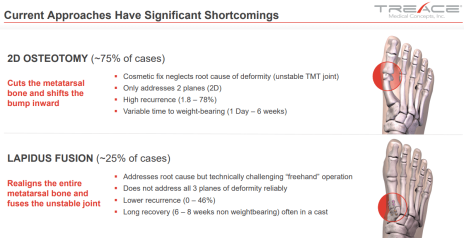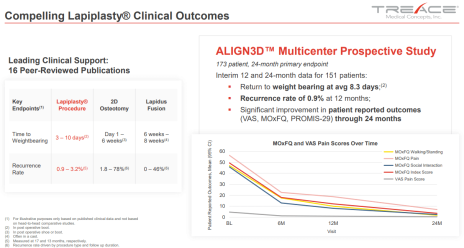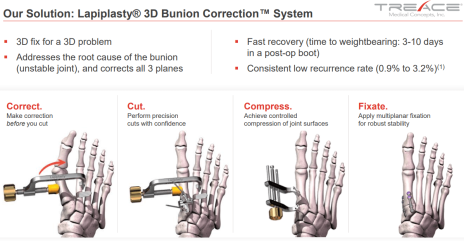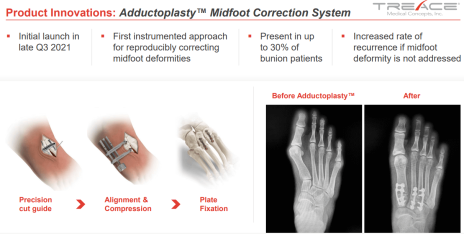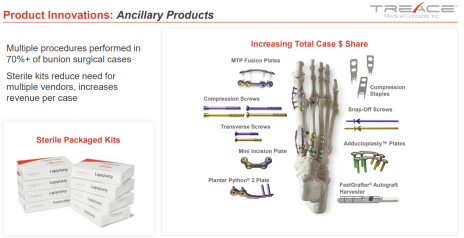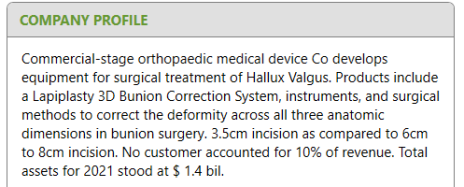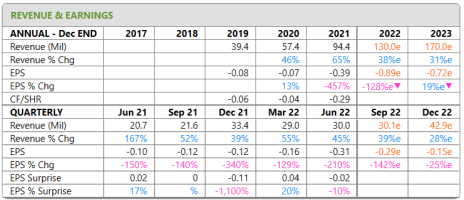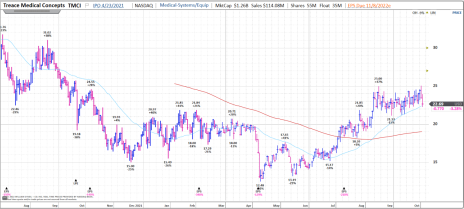The Big Idea
There are a lot of overlooked areas in the world of medicine.
Until a few years ago one of these areas was the glamourous world of bunion treatment. Bunions are those bony lumps that form on the outside of a big toe. The scientific term is Hallux Valgus.
While toe bumps may not seem like a big deal, there are 65 million Americans affected by bunions. That means a roughly $5 billion market. The numbers skew toward older people. 35% of people over 65 years of age are affected. And bunions don’t self-correct.
They can be caused by things like the way somebody walks (foot mechanics) or by the shape of a foot (foot structure). Usually, there is some underlying mechanical, structural or hereditary issue that is exacerbated by wearing shoes that are too narrow and/or by standing for too long.
From a scientific perspective repeat pressure on the big toe joint (the metatarsophalangeal, or MTP, joint) pushes the toe joint out of whack and creates a three-dimensional (3D) misalignment in the foot’s anatomical structure.
Over time the bony bump springs to life. And they hurt.
Typical treatments range from short-term band-aids for less severe cases (Advil, orthotics, PT, etc.) to ineffective and expensive surgical treatments for more intense bunions.
The most common surgeries have been 2D Osteotomy surgery (cuts and shifts metatarsal bone in two dimensions) which mostly addresses the bump and has up to 78% recurrence rates, and Lapidus Fusion surgery (fuses unstable joint) which is hugely dependent on surgeon freehand skill, therefore producing inconsistent outcomes.
In short, with these two procedures, you either get a 2D surgical approach or a freehand approach, neither of which is reliable enough to consistently address a 3D misalignment issue.
Enter the company we’re adding to our portfolio today. Its founders saw the problem in the bunion treatment market and developed a 3D solution to treat the 3D issue.
Their goal is to be the leader in this specialized market and have their solutions become the standard of care. I think that’s entirely possible, and the stock price has yet to reflect the potential.
The Company
Treace Medical Concepts (TMCI) is a pure-play medical device company focused on revolutionizing the market for surgical treatment of hallux valgus, otherwise known as bunions.
For many years, bunion treatment outcomes have been inconsistent, at best. John Treace, founder and current CEO of the company, saw an opportunity to develop better technologies. He started Treace Medical in 2014 to do just that.
Treace developed the proprietary Lapiplasty 3D Bunion Correction System, which combines instruments, implants and surgical methods for bunion surgery. The company received FDA clearance to begin selling its solutions in late 2015.
Since then, Treace has expanded its portfolio with other instruments and implants for use in the Lapiplasty Procedure. Late last year Treace released the Adductoplasty Midfoot Correction System, the first instrumented approach to correct midfoot deformities, which are present in roughly 30% of bunion patients.
The company came public in April 2021 and currently has a market cap of $1.25 billion.
With disruptive technology aimed at a roughly $5 billion domestic market, approval at over 1,750 sites in the U.S., a targeted direct-to-patient outreach program and direct sales reps, and consistently increasing utilization rates Treace Medical appears to have a lot of momentum addressing a niche MedTech market.
In short, it’s exactly what we look for in an early-stage, small-cap opportunity. And most investors have never heard of it.
Earnings come out next Tuesday (November 8) and consensus estimates are calling for Q3 revenue growth of 38%. That growth rate should be about the same for the full year 2022, then (maybe) slow modestly to the low-30% range next year. Given the broad market conditions we will start with a half-sized position.
The Products
Lapiplasty System
With over 42,000 procedures done to date, Treace’s Lapiplasty System has been shown to consistently and reliably correct all three dimensions (transverse, sagittal and frontal) of bunion deformity.
By repairing that which is causing the issue, rather than slicing off a bunion and slapping a band-aid over it, Treace’s technology helps patients get back on their feet in just three to 10 days with extremely low recurrence risk (just 0.9% after 12 months) as compared to alternative procedures including 2D Osteotomy (up to 78% recurrence) and Lapidus Fusion (up to 46% recurrence), which typically require several weeks (up to eight for Lapidus Fusion) for recovery.
The Lapiplasty Procedure involves rotating the metatarsal bone into normal anatomical position (in all three dimensions), getting rid of the bump and restoring normal foot anatomy. Or in layman’s terms, cutting part of the big toe bone, rotating it back into the correct position and screwing it in place.
The previously unstable foot foundation is secured with titanium fixation plates and screws so patients can get into a post-op boot right away.
Adductoplasty Midfoot Correction System
In late 2021 Treace released its Adductoplasty Midfoot Correction System. This procedure moves into the center of the foot to the inside toe bones (second and third metatarsals) and essentially does the same thing to them that Lapiplasty does to the big toe. Adductoplasty often goes along with Lapiplasty in those situations where it can help because surgeons can do a better job in the Lapiplasty by getting those inner bones “out of the way.” The procedure probably adds $2,000 to $3,000 to the Lapiplasty bill.
Ancillary Products
Treace is growing its selection of products that are used to complete procedures and that stay in the foot afterward. While not as material to the business as the procedures themselves, these components and consumables add incremental revenue to each procedure and allow Treace to capture a larger share of total procedure dollars.
Growth Initiatives
Lapiplasty Product Innovation: In Q4 2020 Treace launched the Lapiplasty Mini Incision System, featuring a smaller incision (3.5 cm versus 6cm to 8cm) and higher selling price. In 2022 they highlighted the Micro-Incision System, which takes incision size down to under 2cm and includes a new set of instruments. The Micro system is in clinical trials with an expected rollout later in 2023.
Add New Procedure/Product Solutions: Adductoplasty was launched in Q3 2021 to address midfoot deformities that occur in 30% of bunion patients. The procedure helps to reduce recurrence and should contribute to growth in the coming quarters. Similarly, Treace’s growing offering of ancillary products (plates, screws, staples, etc.) add consumable revenue for each procedure completed.
Physician Preference for Lapiplasty: Treace is a pure-play bunion company entirely focused on being the best in this market. That is driving physicians toward the company while also giving sales teams an open door to pitch a superior technology.
Drive Awareness: Treace has multiple initiatives to drive awareness across surgeons (through webinars, events, courses) and consumers (social media, educational website, doctor search/scheduling tools).
The Business Model
Treace generates the bulk of revenue from the Lapiplasty System, though the Adductoplasty System should start to become a more meaningful portion of revenue over time. Both systems comprise single-use implant kits and reusable instrument tools. They are sold to physicians, surgeons, hospitals and ambulatory surgery centers in the U.S. through both employed sales teams (drove 52% of 2021 revenue) and sales agencies. No customer accounts for over 10% of revenue.
The Bottom Line
Treace grew 2021 revenue by 65% to $94.4 million and delivered adjusted EPS of -$0.39. In Q2 2022 revenue grew by 45% to $30 million and in Q3 is expected to grow by 39% to $30.1 million. Q3 EPS is expected to be -$0.29.
For the full year, 2022 revenue is expected to grow by 38% to $130 million and EPS is expected to be -$0.89. Looking out into 2023 analysts see revenue up 31% to $170 million and a nearly 20% improvement in EPS, to around -$0.72.
Treace ended Q2 with $102 million in cash and cash equivalents and $54 million in debt.
Risk
Pure Play: Treace does one thing and one thing only. If Lapiplasty doesn’t continue to catch on or if there are significant challenges (supply chain, safety issue, etc.) the stock will suffer.
Competitor Leap-Frog: Treace has a nice IP portfolio, but competitors could figure out a way to get around or jump over it and build a better mouse trap.
Sales Force Execution Issues: With over 50% (and growing) of revenue coming from employed salespeople (which are also growing in numbers), Treace is increasingly reliant on its internal sales team to execute. While this is good now, any execution issues or slowed pace of sales team growth could impact growth.
Physician Confidence: Any issues that negatively impact physician confidence in Lapiplasty could spread by word of mouth and slow adoption and/or procedure growth.
Competition
The market leader/competitor is probably Stryker (SYK), followed by Zimmer Biomet (ZBH), Paragon 28 (FNA), Fusion Orthopedics, Nextremity, CrossRoads Extremity, DePuy Synthes, Arthrex, Smith & Nephew (SNN) and In2Bones, all of which play in the market to varying degrees.
The Stock
Trading Volume: TMCI trades an average of 325,000 shares daily.
Historical Price: TMCI came public last March at 17 and shot straight up 50%. Shares peaked around 37.2 last June then made a series of lower highs and lower lows through the end of the year. For the first four months of 2022 TMCI mostly traded in the 17 to 22 range, then the stock sold off into Q1 earnings in May, eventually landing at the year’s low of 12.5. From about mid-June through the end of August TMCI trended higher, getting solidly back above 20. For the last seven weeks, the stock has been consolidating between 21 and 25.
Valuation: TMCI trades with an EV/2023 estimated revenue multiple of around 7.4. That’s relatively low for a high-growth MedTech stock.
Buy Range: Expect to buy in the 21 to 25 range in the near term, probably until after Q3 earnings on November 8 (next Tuesday). Start with a half-sized position. BUY HALF
The Next Event: Q3 earnings are on November 8 (next Tuesday).
Updates on Current Recommendations
| Stock Name | Date Bought | Price Bought | Price on 11/03/22 | Profit | Rating |
| Enovix (ENVX) | 10/6/22 | 20 | 11 | -47% | Buy |
| Evolent Health (EVH) | 9/2/22 | 37 | 26 | – | SOLD |
| Flywire (FLYW) | 8/4/22 | 25 | 19 | -22% | Buy Half |
| Inspire Medical (INSP) | 10/4/19 | 59 | 213 | 265% | Hold |
| Procept BioRobotics (PRCT) | 3/3/22 | 25 | 43 | 70% | Hold Half |
| Rani Therapeutics (RANI) | 10/7/21 & 7/28/22 | 14 | 7 | -51% | Hold |
| Repligen (RGEN) | 11/2/18 & 12/31/18 | 59 | 172 | 191% | Hold |
| Sprout Social (SPT) | 9/3/20 | 36 | 48 | 32% | Hold Half |
| TransMedics Group (TMDX) | 7/7/22 | 34 | 45 | 31% | Hold 3/4 |
| Treace Medical (TMCI) | 11/3/22 | NEW | 45 | NEW | Buy Half |
| Xometry (XMTR) | 1/6/22 | 52 | 57 | 10% | Hold |
Please email me at tyler@cabotwealth.com with any questions or comments about any of our stocks, or anything else on your mind.
Glossary
Buy means accumulate shares at or around the current price.
Hold means just that; hold what you have. Don’t buy, or sell, shares.
Sell means the original reasons for buying the stock no longer apply, and I recommend exiting the position.
Sell a Half means it’s time to take partial profits. Sell half (or whatever portion feels right to you) to lock in a gain, and hold on to the rest until another ratings change is issued.
Disclosure: Tyler Laundon owns shares in one or more of the stocks mentioned. He will only buy shares after he has shared his recommendation with Cabot Small-Cap Confidential members and will follow his rating guidelines.
The next Cabot Small-Cap Confidential issue is scheduled for December 1, 2022.
